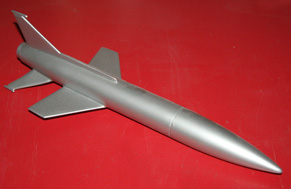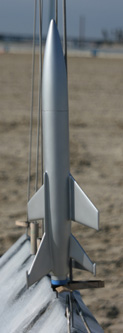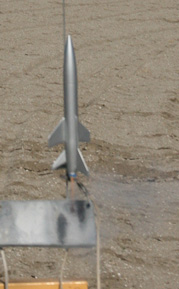Pemberton Technologies Space Ark Jr
Pemberton Technologies - Space Ark Jr {Kit}
Contributed by Todd Mullin
| Construction Rating: | starstarstarstarstar_border |
| Flight Rating: | starstarstarstarstar_border |
| Overall Rating: | starstarstarstarstar_border |
| Manufacturer: | Pemberton Technologies  |
Brief:
 The Space Ark Jr. is a half-scale low power version of Pemberton
Technologies' (Pem-Tech) mid power Space Ark. It is a single stage, parachute recovery model of the rocket seen in the
sci-fi classic "When Worlds Collide". I got my Space Ark Jr. as a matched signed/numbered edition (#8) at the
time Pem-Tech released their new low power line of products with their Bucky Jr. kit.
The Space Ark Jr. is a half-scale low power version of Pemberton
Technologies' (Pem-Tech) mid power Space Ark. It is a single stage, parachute recovery model of the rocket seen in the
sci-fi classic "When Worlds Collide". I got my Space Ark Jr. as a matched signed/numbered edition (#8) at the
time Pem-Tech released their new low power line of products with their Bucky Jr. kit.
Construction:
The components came packaged in a heavy, sealed poly bag. All of the components were accounted for and in good
condition. The parts included are:
- Balsa nose cone
- Balsa tail cone
- BT-60 airframe tubing
- 24mm motor mount tubing
- Kevlar® shock cord
- Parachute
- Nose ballast
- 1/8" balsa fin stock sheet
- 1/4" Launch lug
- 1/8" Launch lug
- Screw eyelet
- Wrap around and tail fin alignment guide
- Super groovy fin template sheet
- 1/8" dowel
- 6 page "Destruction" manual
- Supplemental instruction sheet
This was my first kit from Pem-Tech. I had heard in the past about their infamous "Destructions"... Layne Pemberton obviously has a well developed sense of humor with a writing style similar to Douglas Adams. A very entertaining read. The manual includes an image of the completed model and only 1 illustration. The lack of illustrations is not a problem though, as the build really doesn't require more than the one.
The build starts out by sanding and filling the body tube and nose and tail cones and alignment marks are added to the tube. Next, the nose ballast needs to be added. According to the supplemental instruction sheet, a last minute snafu, the initial batch of kits did not come with a pre-drilled ballast hole in the nose cone. This was easy to remedy with a large drill bit. After the freshly drilled hole was drilled and filled with ballast and Gorilla Glue, I screwed the eyelet into the rear of the cone and set it aside for the glue to cure.
The fins are next. The modeler must trace and cut the fins by hand for this model. Like the design, the fin modeling is retro as well. The lack of laser cutting shouldn't discourage even a moderately inexperienced rocketeer.
Next, alignment marks are put onto the tail cone, which is temporarily mated to the body tube. These are used to cut the "thru-the-tail-cone" fin slots in the tail cone. For a beginner, this might be a challenging step. The slots need to be cut cleanly, straight and correctly sized.
The Kevlar® shock cord is glued to the motor mount and then it is inserted into the tail cone after the slots are cut, and then the tail cone is permanently glued to the body tube. The fins are glued into the slots on the tail cone.
 Next, the gotcha of the kit. The wings are glued to the main body at a different
angle than the fins. This is well illustrated, but if you aren't paying attention, it will ruin the look of the kit.
Also, whereas the manual tells you to glue the wings onto the wing alignment line, it doesn't tell you how far forward
to attach them. I eyeballed them from the photo of the completed kit and decided to put the trailing edge of the wing
just slightly forward of the seam between the tail cone and the body tube.
Next, the gotcha of the kit. The wings are glued to the main body at a different
angle than the fins. This is well illustrated, but if you aren't paying attention, it will ruin the look of the kit.
Also, whereas the manual tells you to glue the wings onto the wing alignment line, it doesn't tell you how far forward
to attach them. I eyeballed them from the photo of the completed kit and decided to put the trailing edge of the wing
just slightly forward of the seam between the tail cone and the body tube.
At this point, I deviated from the "Destructions". The next step is to glue the crossbar on the two lower fins. As this would make the filleting and sealing of the fins much more difficult, I left the crossbar and the fin tip dowels off until after I had put on a good, thick coat of Elmer's Fill N' Finish and Kilz onto the model.
After filleting and filling the balsa, I attached the crossbar, 1/8" launch lugs and fin tip dowels.
One step that is notably missing from the instructions is the attachment of the shock cord and parachute to the nosecone. Probably obvious that this needs to be done to the experienced modeler, but it's omission is noteworthy.
Finishing:
 The finishing on the Space Ark Jr. is about as straight forward as it
gets. After careful sanding and priming, a uniform silver paint scheme with no detailing is recommended to match the
rocket from the movie.
The finishing on the Space Ark Jr. is about as straight forward as it
gets. After careful sanding and priming, a uniform silver paint scheme with no detailing is recommended to match the
rocket from the movie.
For those of you that have not tried to get a "perfect" silver paint job, just a word of caution. Silver is probably the most difficult paint color to work with. It will show any imperfections in your model, so take your time and give this beauty the good, smooth sanding it deserves.
Construction Rating: 4 out of 5
Flight:
I was a bit nervous about launching a rocket of this size and weight on a D12 motor on San Diego's Fiesta Island...
Way too much water all around. I ended up bartering a C11 from someone at the launch and felt much better about it.
The Space Ark does not have a thrust ring so that it can fit a variety of different motors, so the rocketeer must add a wrap of masking tape around the business end of the motor to keep it from sliding up into the model when under thrust.
The rocket had a nice, smooth boost with just a slight weathercock to the flight. The ejection was right at apogee. The C11 is PLENTY of motor for this rocket! I'm glad I didn't go up to the D12...
Recovery:
The shock cord on the Space Ark is an extra long length of Kevlar®.
This might sound a little weird...but just a bit too long! Not something you normally hear as a comment with other
manufacturers providing extremely short shock cords with their kits!
The Space Ark ejected perfectly at apogee and came down swinging around itself on the descent. Couldn't figure out why until the model got to the ground. The shock cord had bound around the shroud lines of the parachute allowing it to only partially inflate.
Even with a partially opened 'chute, there was not damage on landing.
Flight Rating: 4 out of 5
Summary:
 Overall, building and flying Pemberton Technologies Space Ark Jr. has
been a really enjoyable experience. The oversimplified 1950's classic design has been translated into a rocket that
gets attention at a launch.
Overall, building and flying Pemberton Technologies Space Ark Jr. has
been a really enjoyable experience. The oversimplified 1950's classic design has been translated into a rocket that
gets attention at a launch.
The materials supplied with the kit are top notch. The "destructions" are a highly entertaining read and are still easy to follow. There are a few omissions of steps, but in my experience, Pemberton Technologies is extremely responsive to e-mails.
For my next launch of the Space Ark, I'm planning on adapting the 24mm motor mount down to a 18mm mount. With the C11 motors becoming harder to come by, I will probably permanently mount the adapter to be able to fly on the smaller motors.
Overall Rating: 4 out of 5
Other:
Update: I made the 18mm flight with good success. I have glued the mount in permanently. I have forwarded comments on
to Pem Tech about the destructions and they have told me that they will be revised on the next production run.
Other Reviews
- Pemberton Technologies Space Ark Jr By Geof Givens (August 22, 2008)
Brief: The Space Ark Jr. is a downscale of Pemberton Technology's midpower rocket. Layne Pemberton offers a lot of really cool retro-futuristic designs. He's also a nice guy whose instruction booklets are well known for their humorous off-beat writing style. Construction: The package arrived with all necessary parts in good condition, except that the balsa nose cone had a ...
 |
 |
Flights
 |
 |
G.H.G. (September 9, 2008)
M.A. (September 12, 2008)
 |
 |
P.T. (September 8, 2008)